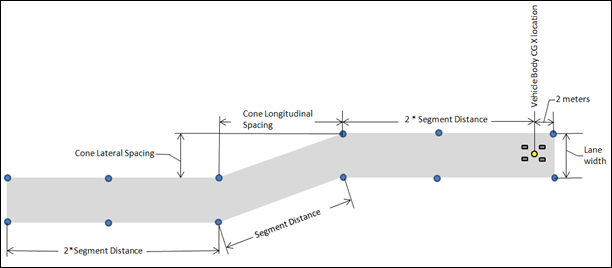Single Lane Change
A Single lane change event drives the vehicle through a single lane change, attempting to follow the centerline of the defined lane.
You can define the speed of the lane change, along with the lane dimensions. A steering controller is used to follow the path and a torque controller is used to maintain speed through the event. The event supports right and left lane changes. A plot template is available to plot the results.

Figure 1. Single Lane Change - Path

Figure 2.
| Parameter | Description |
|---|---|
| Lateral offset | Lateral offset of the lanes. |
| Length- Section 1 | Length of the initial section of road in meters. |
| Length- Section 2 | Longitudinal length of the transition section of road. It is where the lane change occurs. |
| Length- Section 3 | Length of the recovery straight section of road. |
| Turn direction | Direction the vehicle turns during the event (as seen by the driver). |
| Velocity | The initial speed of the vehicle (meters/second). |
| Look ahead time | Look ahead time used by the driver model in seconds. |
| Prediction step size | Maximum step size that the solver can take, in seconds (if the number is .02, maximum step size is .02 seconds). |
| End time | Absolute end time of the event, in seconds. |
| Print interval | Data is output to the plot files and graphics file at this time interval. |

Figure 3.
References
ISO 3888-2-2011 Passenger cars — Test track for a severe lane-change maneuver.
NATO Allied Vehicle Testing Publication AVTP: 03-160 Sep. 1991.